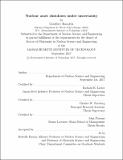Nuclear asset shutdown under uncertainty
Author(s)
Haratyk, Geoffrey
DownloadFull printable version (5.245Mb)
Other Contributors
Massachusetts Institute of Technology. Department of Nuclear Science and Engineering.
Advisor
Richard K. Lester and Charles W. Forsberg.
Terms of use
Metadata
Show full item recordAbstract
The restructuring of the power sector that began in the 1990s created acute competition for nuclear power plants. While merchant reactors benefited from this change in the early years, recently they started to retire for economic reasons well before the expiration of their operating licenses. This unexpected wave of premature shutdowns has severe implications for energy and climate policy. It invites us to re-assess the viability and role of nuclear in a transitioning energy sector. The thesis first develops two new tools aimed at measuring nuclear competitiveness and informing retirement strategies: (1) a structural model of electricity markets based on supply and demand equilibrium and (2) a long-term asset valuation framework accounting for stochastic price dynamics and flexible retirement options. We employ these tools to analyze the challenges facing nuclear energy in two countries: the United States and Japan. After evaluating the drivers and likelihood of premature retirements, we discuss a range of technological innovations and regulatory options that could help nuclear bring value to future competitive markets. We show that low natural gas prices and stagnant electricity demand have been responsible for the drop in nuclear plant revenue in the United States. We measure that renewable wind and solar PV impact nuclear operations only for penetration levels above 15% and 30% respectively. We also find that spot price volatility, a feature of competitive markets, defers nuclear retirement decisions rather than precipitates them. In this context, nuclear must adapt. Greater operational flexibility can prevent financial losses in areas where renewables are being deployed on a large scale. In the medium-term, heat storage technologies would protect plants' profitability while enabling deep decarbonization of the energy sector. Finally, a few plants may be able to reach niche markets by diversifying their output beyond electricity. We recognize that the carbon-free attributes of nuclear energy are not valued in competitive markets. Yet, even a moderate price on carbon would save most reactors. If not possible, states may adopt nuclear subsidies to meet their policy objectives. As a last resort, the exercise of a new mothballing license could prevent the irreversible loss of nuclear assets.
Description
Thesis: Ph. D., Massachusetts Institute of Technology, Department of Nuclear Science and Engineering, 2017. This electronic version was submitted by the student author. The certified thesis is available in the Institute Archives and Special Collections. Cataloged from student-submitted PDF version of thesis. Includes bibliographical references (pages 197-208).
Date issued
2017Department
Massachusetts Institute of Technology. Department of Nuclear Science and EngineeringPublisher
Massachusetts Institute of Technology
Keywords
Nuclear Science and Engineering.